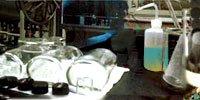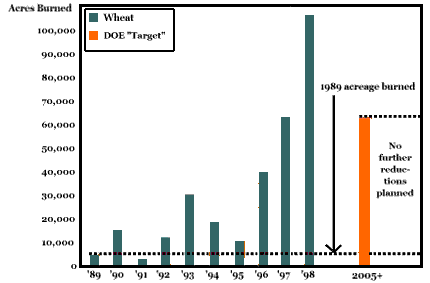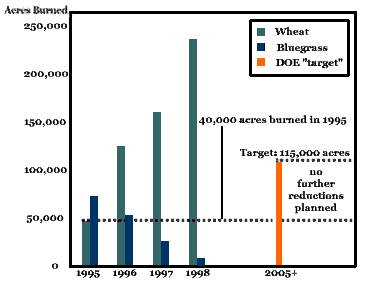 | |||||||||
Scientific Research |
|||||||||
home | scientific research | |||||||||
 |
Read here about the history of wheat and grass burning. "Stubble burning, if used regularly contributes to erosion and the loss of organic matter."1995 Agricultural Research Special Report by Agricultural Research Center and USDA. Research on the chemistry of grass smoke and wheat stubble can be found here: www.csmt.ewu.edu/csmt/chem/ Citizens can track the air monitors around the region in real time by usink this link: http://airr.ecy.wa.gov/ Here is a break down of toxic chemicals found in the field burning smoke A breakdown of Idaho Annual PM-10 Emissions Estimate by the Idaho DEQ. A study by NRCS in Montana on the Effects of burning on soil quality Impact of agricultural activities including biomass burning on the greenhouse effect. Study produced by the Unites States Department of Agriculture. | ||||||||
|
Grass Research - A Betrayal of Money and Faith | |||||||||
For three long decades the public has given Grass Growers their money and their faith. Money was in the form of millions of dollars in state and federal grants, contributed by the same people who suffered the effects and paid the price of grass field smoke. Faith was given believing the industry was honestly spending the funds to find an alternative to burning which would end the public's suffering. A review of grass research shows a long history of betrayal. The Grass Industry did not conduct research which would find an alternative to field burning. Time and again, projects designed to fail were funded and projects which showed promise were killed. Instead, research money was used to justify burning, to buy time, and to convince the public progress was being made.
Bogus Research?
Grass Growers use burning to dispose of straw and residue left on their fields after harvest. They also claim that the burning maintains good seed yields. Any alternative to field burning must therefore solve the problem of how to economically remove the straw and residue (dethatching), what to do with straw after it is re-moved, and how to increase seed yields to offset increased productions costs. We discovered that essentially no research has been done to solve any of these problems. A Change In Direction?
Those of us who had hoped that the industry would redirect its research funding priorities in the face of regulation in Washington were disappointed. The industry has chosen to ignore recent research which has identified varieties of bluegrass that could be grown economically without burning. The industry has chosen instead to continue to fund projects to justify burning. (See the SOS Presentation at the Annual Grass Research Meeting.) Grass growers in this region spend nearly $1 million in federal grants each year to conduct their research. All research decisions are made by the industry. The public pays the bills but has no voice in how the money is spent. | |||||||||
|
Whitman County - Ground Zero | |||||||||
The seasons are written in colors on the rolling hills - brown earth in the fall, white blankets of snow in winter, green velvet wheat in spring, and golden grain in summer. This is Whitman County, the heart of Eastern Washington farm country, with nearly a half million acres in wheat production. Its biggest city, Pullman (pop. 25,000), is home to Washington State University. For almost half a century, Whitman County farmers were nearly "smokeless" and lived in harmony with the land, their residents and their big-city Spokane county neighbors to the north. Then, about 10 years ago, a few farmers began burning their wheat fields after harvest. Burning spread like wildfire and touched off a conflagration which has made Whitman County the Center of the controversy over wheat stubble burning. Between 1989 and 1998, burning increased from 5,900 to 107,000 acres. The 5,230 tons of particulate pollution originating from these fields is nearly equal to the total amount of pollution from all wood stoves and all industrial facilities in all of Eastern Washington in the couse of an entire year.
The graph below, which appeared in the Spokesman Review (1/31/99), chronicles the escalation. Also shown is the Department of Ecology's voluntary "target"* for reductions in burning. As seen, in 2006, there will be nearly ten times more smoke than there was in 1989. | |||||||||
Wheat Stubble Burning - Whitman County | |||||||||
People struggling with the smoke from Whitman County have complained to the Department of Health, county commissioners, the Department of Ecology, legislators and the EPA. A WSU administrator heard from angry students and "learned first hand that (the smoke) can create a life-endangering situation." The Pullman City Council and the Whitman County Public Health Officer appealed to the county commissioners. Smoke blowing north also set off protests from Spokane County where farmers do not burn their wheat stubble. The Spokane County Air Pollution Control Board appealed to the Governor in a February 12, 1999 letter, saying: "Our economic well being and public health depend on your intervention." All protests and appeals have been dismissed or ignored.
On February 9, 1999, the DOE signed a Memorandum of Understanding with the Washington Association of Wheat Growers which calls for voluntary 50% "phase-down" in 7 years beginning with acreage burned in 1998. The agreement will perpetuate large scale wheat stubble burning indefinitely at levels not seen since the 1940s. | |||||||||
In Their Own Words | |||||||||
"What is especially troubling is that the rapid growth in wheat stubble burning is quickly replacing the hazard of blue-grass burning" | |||||||||
Dr. Michael McCarthy, Lung Specialist, Tri-City Herald 8/20/98 | |||||||||
"I...have learned first hand that it (wheat stubble burning) can create a life-endagering situation." | |||||||||
K.J. (Gus) Kravas, Vice Provost for Student Affairs, WSU 11/9/98 | |||||||||
"I...have learned first hand that it (wheat stubble burning) can create a life-endagering situation." | |||||||||
K.J. (Gus) Kravas, Vice Provost for Student Affairs, WSU 11/9/98 | |||||||||
"If I had known that this happened, I would have never come to this side of the mountains." | |||||||||
Rebecca Hensly, who was hospitalized by smoke, WSU Student 10/98 | |||||||||
"The amount of wheat fileds being burned is insignificant."Tom Mick, CEO, Washington Wheat Commission. (Tri-City Herald, 8/19/98) "Such a tiny number of acres...will have a minimal impact on air quality." | |||||||||
Washington Association of Wheat Growers Press Release 1/5/99 | |||||||||
Wheat Stubble and Bluegrass | |||||||||
| The debate over bluegrass burning raged for 35 years.Then, in May 1995, citizens came together to demand an end to the burning which had escalated from a few thousand acres in the 1950s to 60,000 acres by 1995, with no end in sight. In March 1996, Spokane and Coeur d'Alene lung specialists joined the debate. At a press conference held to announce their opposition to grass burning, they presented a petition signed by over 300 local physicians calling for an end to the burning. Within a week, the Washington State Department of Ecology (DOE) declared a public health emergency, instituted an immediate 1/3 reduction in burning and promised a ban by the summer of 1998. Wheat growers responded. Fearing that they would be next, they torched a record number of acres in the fall of 1996 in order to increase their baseline as protection against regulation. In the words of one Palouse grower: "The bluegrass edict has prompted a backlash among farmers. Whitman County has gone bananas burning. Farmers know they are on a two to three year timeline before burning is further curtailed." Spokesman Review, 4/5/97. The DOE, bowing to political pressure, took no steps to
stop the escalation. Instead, in February 1999, the DOE entered into
a voluntary agreement with the Wheat Growers Association which calls for
a "voluntary" 50% reduction in burning in 7 years - beginning with acreage burned in 1998.
The graph below compares bluegrass and wheat stubble burning between 1995 and 1998. Also shown, is the "voluntary" target which has been hailed as "progress" by wheat industry leaders. |
|||||||||
| Acreage Burned 1995 - 1998 (with projected "voluntary" target)  | |||||||||
No Escalation?
| |||||||||
"Acreage has grown dramatically in the last
few years. There was three times as much burning last year (1996) as the
year before." | |||||||||
Grant Pfeifer, DOE spokesman. Capital Press, 10/31/97 | |||||||||
|
In the fall of 1998, however, the Wheat Growers Association adopted the position that no escalation in burning had occurred. They claimed that farmers were burning without permits prior to 1998 because the permit system was "new" and farmers had not yet learned the requirements | |||||||||
In spite of the fact that burn permits have been required
since 1977 (WAC 173-425) and that there is no documentation to support
the wheat industry's allegation, the DOE reversed its position. After
first publicly announcing that 1998 would not be the starting point for the 'voluntary' phase down because burning "may have been bumped up
in anticipation of the new regulations,"* the agency publicly repudiated
their own records, and accepted 1998 as the baseline. (See Politics
and Collusion and Whitman County-Ground Zero ) Spokesman Review, 1/6/99 | |||||||||
contact via email: Save Our Summers or: P.O. Box 30174, Spokane, WA 99223-3002 | |||||||||
site designed and coded by ©buffalo girls productions | |||||||||